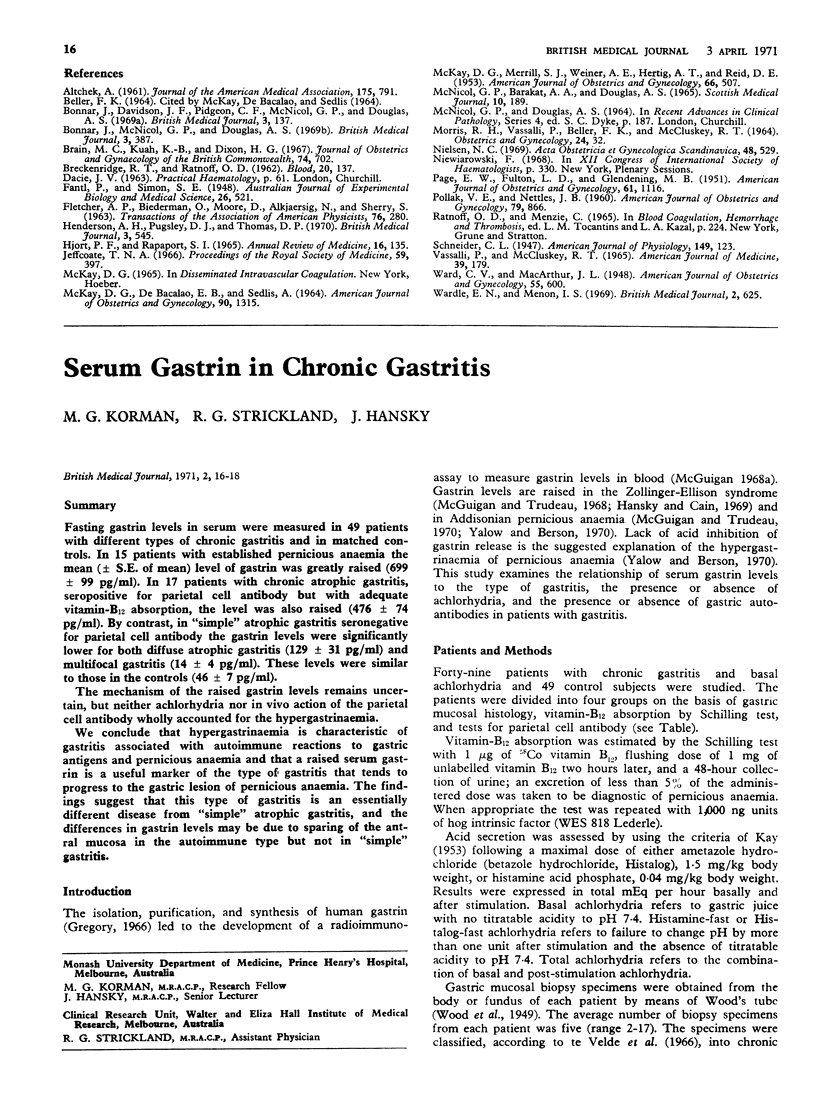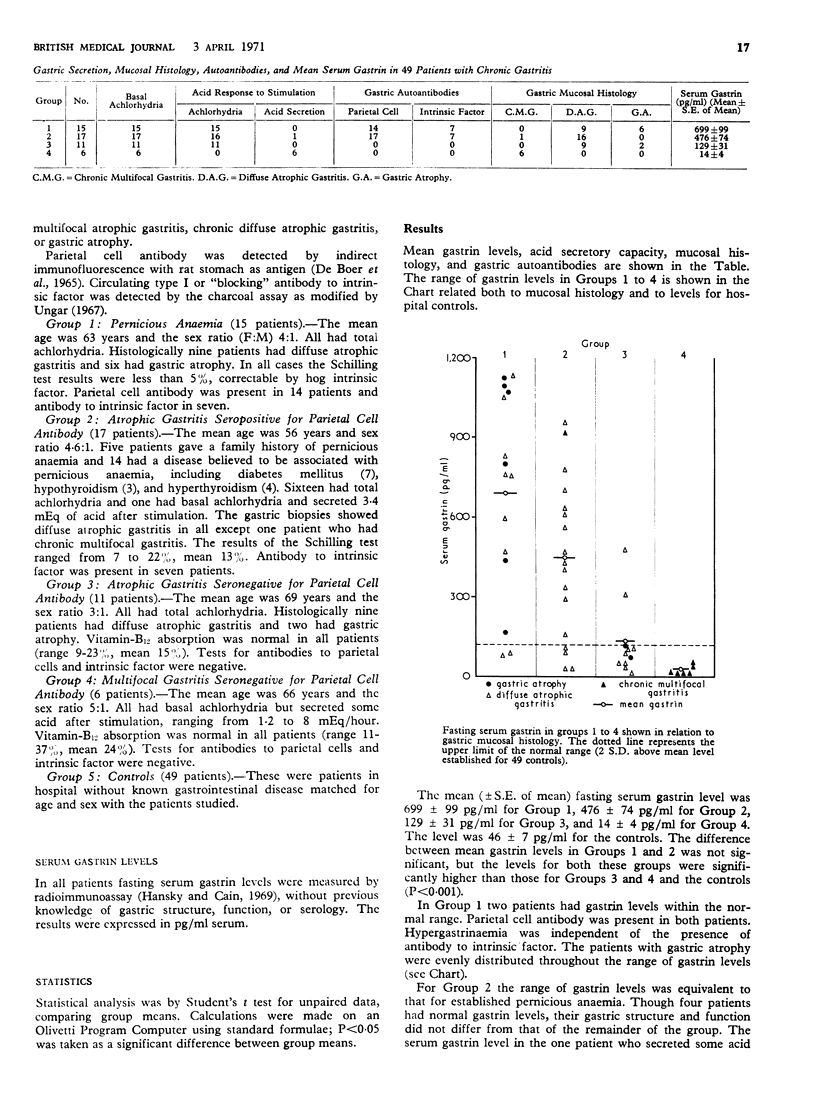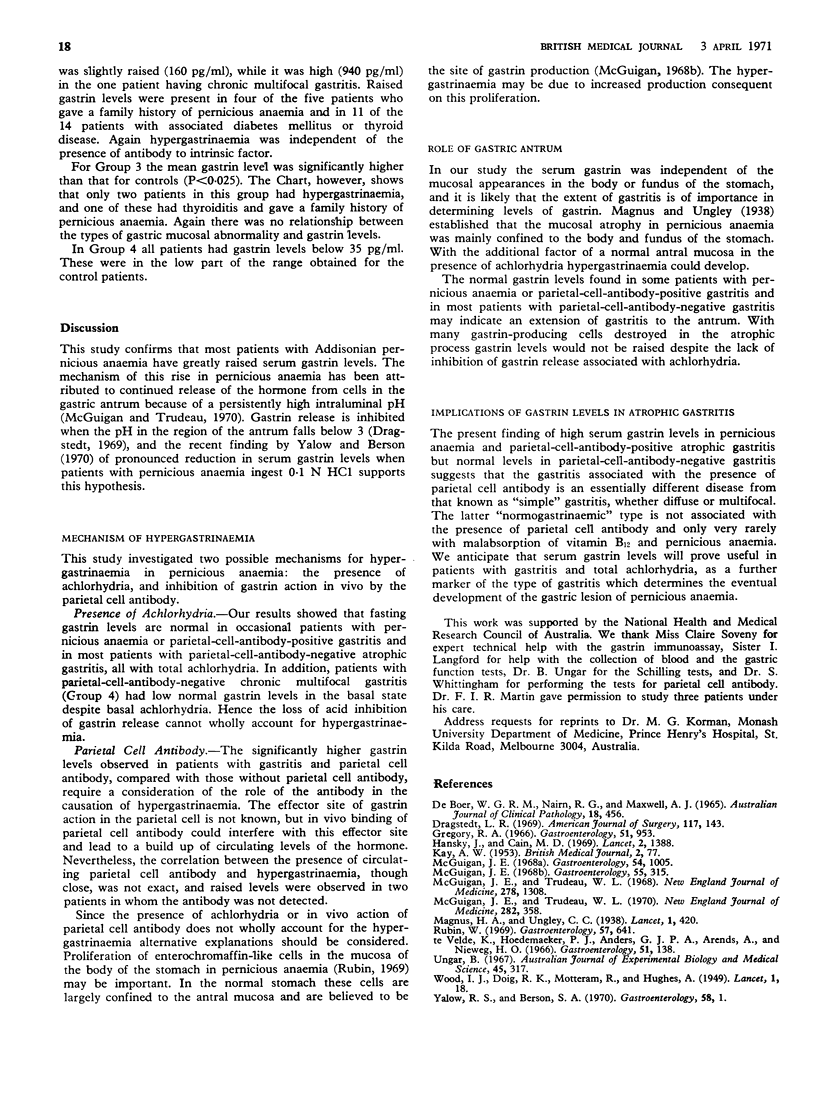Abstract
Fasting gastrin levels in serum were measured in 49 patients with different types of chronic gastritis and in matched controls. In 15 patients with established pernicious anaemia the mean (± S.E. of mean) level of gastrin was greatly raised (699 ± 99 pg/ml). In 17 patients with chronic atrophic gastritis, seropositive for parietal cell antibody but with adequate vitamin-B12 absorption, the level was also raised (476 ± 74 pg/ml). By contrast, in “simple” atrophic gastritis seronegative for parietal cell antibody the gastrin levels were significantly lower for both diffuse atrophic gastritis (129 ± 31 pg/ml) and multifocal gastritis (14 ± 4 pg/ml). These levels were similar to those in the controls (46 ± 7 pg/ml).
The mechanism of the raised gastrin levels remains uncertain, but neither achlorhydria nor in vivo action of the parietal cell antibody wholly accounted for the hypergastrinaemia.
We conclude that hypergastrinaemia is characteristic of gastritis associated with autoimmune reactions to gastric antigens and pernicious anaemia and that a raised serum gastrin is a useful marker of the type of gastritis that tends to progress to the gastric lesion of pernicious anaemia. The findings suggest that this type of gastritis is an essentially different disease from “simple” atrophic gastritis, and the differences in gastrin levels may be due to sparing of the antral mucosa in the autoimmune type but not in “simple” gastritis.
Full text
PDF


Selected References
These references are in PubMed. This may not be the complete list of references from this article.
- DEBOER W. G., NAIRN R. C., MAXWELL A. PERNICIOUS ANAEMIA AUTOANTIBODY TO GASTRIC PARIETAL CELLS: IMMUNOFLUORESCENCE TEST WITH RAT STOMACH. J Clin Pathol. 1965 Jul;18:456–459. doi: 10.1136/jcp.18.4.456. [DOI] [PMC free article] [PubMed] [Google Scholar]
- Dragstedt L. R. Peptic ulcer. An abnormality in gastric secretion. Am J Surg. 1969 Feb;117(2):143–156. doi: 10.1016/0002-9610(69)90298-0. [DOI] [PubMed] [Google Scholar]
- Gregory R. A. Memorial lecture: the isolation and chemistry of gastrin. Gastroenterology. 1966 Dec;51(6):953–959. [PubMed] [Google Scholar]
- Hansky J., Cain M. D. Radioimmunoassay of gastrin in human serum. Lancet. 1969 Dec 27;2(7635):1388–1390. doi: 10.1016/s0140-6736(69)90933-7. [DOI] [PubMed] [Google Scholar]
- McGuigan J. E. Gastric mucosal intracellular localization of gastrin by immunofluorescence. Gastroenterology. 1968 Sep;55(3):315–327. [PubMed] [Google Scholar]
- McGuigan J. E. Immunochemical studies with synthetic human gastrin. Gastroenterology. 1968 Jun;54(6):1005–1011. [PubMed] [Google Scholar]
- McGuigan J. E., Trudeau W. L. Immunochemical measurement of elevated levels of gastrin in the serum of patients with pancreatic tumors of the Zollinger-Ellison variety. N Engl J Med. 1968 Jun 13;278(24):1308–1313. doi: 10.1056/NEJM196806132782402. [DOI] [PubMed] [Google Scholar]
- McGuigan J. E., Trudeau W. L. Serum gastrin concentrations in pernicious anemia. N Engl J Med. 1970 Feb 12;282(7):358–361. doi: 10.1056/NEJM197002122820703. [DOI] [PubMed] [Google Scholar]
- Rbin W. Proliferation of endocrine-like enterochromaffin) cells in atrophic gastri mucosa. Gastroenterology. 1969 Dec;57(6):641–648. [PubMed] [Google Scholar]
- VELDE K T. E., Hoedemaeker P. J., Anders G. J., Arends A., Nieweg H. O. A comparative morphologcal and functional study of gastritis with and without autoantibodies. Gastroenterology. 1966 Aug;51(2):138–148. [PubMed] [Google Scholar]
- Yalow R. S., Berson S. A. Radioimmunoassay of gastrin. Gastroenterology. 1970 Jan;58(1):1–14. [PubMed] [Google Scholar]


